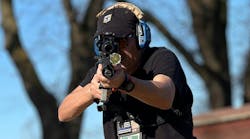The federal government recommends law enforcement agencies trace all firearms, but many of Iowa's largest police departments traced half or fewer of the guns they took into custody in 2012, a Gazette review shows.
Some departments blamed lack of staff and long waits for tracing by the U.S. Bureau of Alcohol, Tobacco, Firearms and Explosives. Others said tracing rarely helps solve local crimes.
"The last time I traced a gun was five years ago," said Sioux City Police Lt. Mark Kirkpatrick. "It's kind of a haphazard system."
But there's a new federal push to increase gun tracing following the Newtown, Conn., school shooting in December. Among proposals considered by a commission led by Vice President Joe Biden was a plan to create a national database of gun purchases, which would improve the tracing process.
ATF traces provide law enforcement agencies with the manufacturer and original buyer of a firearm, information that can link a suspect to a crime or indicate whether a suspect obtained a gun illegally.
Johnson County officials are trying to figure out when and where weapons used in a March 10 shootout in North Liberty were purchased -- information that could come from an ATF trace. Taleb Salameh, who shot three officers non-fatally before he was shot and killed by police, had a permit to acquire a firearm, but investigators would still like to know how he got his weapons, Sheriff Lonny Pulkrabek said last week.
Tracking data also can reveal how guns flow across the nation and stop gun trafficking, federal officials said.
Handgun tracking
The ATF traced 1,304 guns recovered from Iowa in 2011, the most recent data available. Of those traces, requested by 116 Iowa agencies, 46 percent were for handguns, 27 percent shotguns and 26 percent rifles.
Nearly 68 percent of Iowa crime guns traced through the ATF were originally purchased in Iowa, the ATF reported. Besides Iowa, more guns recovered here came from Nebraska -- 28 -- than any other state.
The Des Moines Police Department has requested the most traces in recent years, ATF data shows. DMPD traced 265 guns in 2012 -- nearly all the firearms they took into custody.
Cedar Rapids police traced about half of the 161 guns taken into custody last year, despite a written policy saying they trace all firearms.
Chief Wayne Jerman, hired in September, said the department traces all firearms involved in criminal investigations. Guns not traced could include firearms citizens ask police to hold to prevent possible suicide of a family member, he said.
"There were some cases where a trace may have been determined to be futile or not necessary and no trace was requested," Jerman wrote in an email. "While this may have not been in compliance with policy, it was done to conserve resources by not asking the (Iowa Division of Criminal Investigation) and/or ATF to conduct a trace."
The CRPD policy on firearms is among policies under review, Jerman said.
Sioux City and Davenport traced 20 percent and 18 percent, respectively, of the guns they took into custody in 2012. The Coralville Police Department seized 12 guns last year and traced six of them. Waterloo and Iowa City didn't know how many ATF traces their departments had requested, but officers said trace information often wasn't useful.
"Who actually purchased (the gun), may or may not be a factor in the case," Waterloo Police Capt. Tim Pillack said.
No electronic database
TV shows and movies portray police tapping into an electronic gun database, but federal law prohibits the creation of a nationwide registry of gun purchases. Gun-rights groups have argued such a database could be used to seize citizens' weapons.
Instead, employees at the ATF's National Tracing Center in West Virginia use a gun's serial number to trace it from manufacturer to first buyer. This is often done through multiple phone calls and sorting through paper files.
"It's basically a manual process," said Trista Frederick, public information officer for the ATF Kansas City Field Division.
The ATF traced more than 344,000 firearms in fiscal 2012, with an average trace time of five days, the bureau reports. Guns involved in murders or other serious crimes can be traced in 24 hours, Frederick said.
But Iowa law enforcement officers reported waiting two weeks to nine months for traces.
"It just takes forever to get them back," Coralville Police Chief Barry Bedford said. "In one case, we put in a trace request last July and we still don't have anything back."
The Johnson County Drug Task Force, which combines officers from Iowa City, Coralville, University of Iowa and other agencies, traces almost all the guns seized in drug investigations because of the clear link between drugs and guns, Iowa City Police Officer Jerry Blomgren said.
"We definitely see people trafficking in drugs also trafficking in weapons," he said.
The task force recently caught a man transporting an assault rifle on Megabus, a low-cost bus carrier with hubs in Iowa City and Des Moines, Blomgren said. Officers checked the gun's serial number with the NCIC and learned it had been stolen from somewhere near Des Moines, he said.
The task force also requested an ATF trace, which could confirm that the gun was stolen. If the case goes to federal court system, Blomgren said, prosecutors want officers to do ATF traces.
New push for tracing
A Jan. 16 memo from President Barack Obama required all federal law enforcement agencies to trace all guns they take into custody.
"If federal law enforcement agencies do not conscientiously trace every firearm taken into custody, they may not only be depriving themselves of critical information in specific cases, but may also be depriving all federal, state and local agencies of the value of complete information for aggregate analyses," the memo states.
The U.S. Attorney's Office Northern Iowa division has prosecuted several cases in recent years in which ATF traces revealed more serious crimes, Assistant U.S. Attorney Peter Deegan said.
In one case, three men were found with three guns, Deegan said. The ATF trace showed all three weapons had been purchased by one man, who investigators determined was acting as a "straw buyer" for felons who weren't allowed to legally buy guns.
"By doing the trace, a larger criminal scheme can be discovered," he said.
The ATF referred 192 people for criminal prosecution in Iowa in 2008, the most recent year for which data is available from the Transactional Records Access Clearinghouse, a Syracuse University organization that collects federal court statistics. There were 156 ATF convictions in Iowa in 2008 and 142 people were sentenced to prison for ATF crimes.
In January, 735 people were charged with new ATF cases nationwide, with the most common lead charge being "firearms; unlawful acts."
Copyright 2013 - The Gazette, Cedar Rapids, Iowa
McClatchy-Tribune News Service


